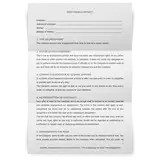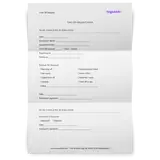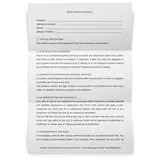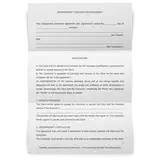An eviction notice template is often used when tenants need to be informed that they are currently breaching the terms of their lease in a specific rental property. This makes this document highly necessary when you may need to carry out multiple evictions or keep the process consistent.
Here’s a sample Eviction Notice template that can be easily customized and adapted to meet your requirements. It’s free to download and use.
What is an eviction notice?
An eviction notice is often delivered in the form of a letter written to the tenant by the property owner. In most cases, such letters are used to notify tenants that they have failed to make the required payments for their rent. However, special eviction notices can also be used to inform your tenants that they have violated any other term in the lease agreement.
These notices are an important and effective way of explaining to your tenant that there is currently an issue that must be solved. It could be a lease violation or some other form of violation notice periods in the rental agreement that can be a cause for legal action down the line.
If they are unable to “cure” this problem, then they must either vacate the premises or challenge the eviction process in a court of law. Additionally, as these documents are in written format, they act as a formal record of the start of the eviction process beginning.
So, although you have verbally informed your tenant of this issue, you may not be able to legally begin eviction until this notice is delivered and they know about the breach of contract.
Many eviction notices may also provide an ultimatum for your tenants, as stated in the rental contract. For example, you may have come across a 30-day eviction notice template. In this case, the property owner declares that the renter must fix the problem within 30 days or vacate the premises.
Why should you use an eviction notice template?
If you are a landlord that owns multiple pieces of property, you will have to deliver multiple eviction notices over time. Writing up the terms of eviction each time that you need to inform a client that they currently owe rent can be tedious, and you may also find that most tenants would resolve the issue upon receipt of the notice.
So, having an eviction notice template is a legal document that can streamline the process by making it consistent, which will give you more time to focus on other issues.
Additionally, by using a notice of eviction template, you can be assured that you are following the correct procedures for evicting a tenant. For example, most states require that you deliver a “grace” period for every tenant to solve the issue e.g., a 30-day notice. If you do not provide this in your eviction letter, then the tenant can challenge it on a technicality. This will mean that you must restart the process.
What should be included in the eviction notice:
To ensure that your eviction is indisputable, your eviction notice template must include the following details:
Addresses
Your eviction notice must include the complete street address of your tenant. This is an incredibly important part of the document because it states whom it applies to as well as indicating that the letter has been written to a tenant who lives at the actual address that you are currently leasing out.
Dates
Many people view the dates on an eviction notice as the backbone of the document. This is because it can be used to trace the process leading up to the receipt of the letter and what is to be expected afterward. So, if you need to deliver a letter of eviction due to rent issues, then you must include the following dates:
- The date that the lease was signed.
- The rent period that is currently being owed.
- The date that the rent payment was expected.
- The number of days the tenant has to pay the rent from the day the eviction letter is received.
For this type of notice, dates and the time frame are crucial if a breach of the rental contract happens and you get to an eviction lawsuit. You don't need an eviction lawyer to prevent paying the additional costs you might run into.
Reason for eviction
You cannot expect your tenants to immediately know why they are being evicted. Even if you have discussed this reason with your tenant verbally, failure to inform them in a formal letter can lead to your eviction process being challenged.
So, to avoid this, you must explicitly state what reason you have for filing an eviction against your tenant. Specify what makes for a lease violation and a breach of the rental agreement - whether it's property damage with a high cost of repair, being late with rent payments, making excessive noise or performing some illegal activity on the property.
Days the tenant has to solve the problem
This is one of the main reasons why you may have your eviction process stopped in court. So, this must be stated in your letter to your tenant. In some cases, a tenant may not be aware that their actions have led to a breach of their lease. So, by law, every tenant has a chance to solve the issue in a given amount of time before any additional action is taken against them.
Before sending this notice, we also suggest that you confirm with the housing laws that the number of days you have set is legal. You must not simply choose an arbitrary figure e.g., three days, and set it as your ultimatum period as most states already have minimum periods of grace that you must give your tenant.
So, if your state requires that each tenant has a 30-day notice before they can be evicted but your eviction letter tells them they have 10 days to solve the issue, then it is within the tenant’s rights to challenge this process and you'll be stuck with even more lawyer fees and a huge cost of eviction.
Whether you have a minimum 3-day notice or more in your rental agreement depends entirely on your local and state laws. Make sure to check the standard notice periods in lease terms in your area, regarding the time frame for the payment of rent, consequences for unpaid rent, and more. These are pretty strict procedures in just about every state in the US.
Most importantly, these legal procedures are there to protect both the landlord and the tenant. In normal circumstances, most landlords don't get to court or ever see an eviction lawyer.
If your eviction lawsuit is started without proper legal grounds and you're not respecting the minimum notice period, the legal process could actually come back and cause issues for you. You'll end up paying the attorney fees and the property in question will still have the same tenant after the legal process is done - but the relationship will be ruined.
Proof of service
When you write a notice of eviction to a tenant, a Judge must be able to confirm that all Civil Procedures have been followed. This includes ensuring that the tenant received the notice i.e., a tenant can always claim that they never received your letter, which will easily lead to your case being dismissed. These are strict steps that need to be followed, every time.
For this reason, eviction notices are always filed with proof of service. This is a court-recognized document that is used to indicate that you served the notice to the tenant on a given date. It must also include how the notice was sent (the delivery method) e.g., postage, personal delivery, and email address, and include the full address of the tenant whom you have filed it for.
There are different types of eviction, which is why you should be familiar with the eviction laws in your area and state.
Common types of eviction notices
While the lease terms and the notice of termination can look different for every landlord, there are certain types of notices that are the most common around the United States, each with proper procedures to follow.
Notice to quit or pay rent
This is the simplest legal notice that tells the tenant they have a period to pay their overdue rent or they can leave your premises. This can be a 3-day, or 10-day notice, depending on the type of eviction notice form you opt for.
Notice to cure or quit
This is the legal notice for the tenant to fix an issue in a specific period on time or they will be evicted. This is a proper notice for someone who is causing excessive noise, performing illegal activities, etc.
Unconditional quit notice
If there are repeat cases of breaches, such as late rent and you've given an adequate time period for the issue to be resolved, you can give them an unconditional notice telling them that they need to evict the premises.
Mont-to-month tenancy termination notice
If the original lease agreement is done on a month-to-month basis, you need to give a 30-day notice period for your tenants.
Lease termination notice
If you have a fixed-term lease with your tenants, as the owner or property manager, you don't have to disclose a reason for the termination of the lease, regardless of the type of property or property details.
Final thoughts
Evictions are always going to be a complicated process and, as a property owner, you should always expect some form of pushback from your tenants. However, you cannot evict any individual or group without an air-tight notice of eviction that follows the local housing laws of your state. If they don't pay the rent on time, go past their lease expiration date, or do something else, you can start the lease termination procedure.
To help you with this process, we have provided a free eviction notice template - you don't even need a document tool to get started.
However, while our eviction notice template pdf or eviction notice template word file is a great sample document that you can use to begin the eviction process, we advise that you add any additional details that are legally required for evictions in your state. Also, before it's too late and you need attorney services, use screening services first to save yourself some trouble.
FAQ on eviction notice
Let’s clear the doubts regarding the eviction notice.
What is the meaning of an eviction notice?
An eviction notice is a formal document that a property owner uses to notify a tenant that they are in breach of their lease agreement. It could be for reasons like unpaid rent or lease violations. The notice gives the tenant a chance to resolve the issue or vacate the rental property.
How do I write a quick notice to a tenant?
To write a quick eviction notice, use a template like the ones available through Unrubble. Include key details such as the tenant’s name, rental property address, lease violations, and the time frame to resolve the issue. Make sure to state whether the notice is due to past due rent or another violation.
What does it mean when a tenant is evicted?
When a tenant is evicted, it means the property owner has started legal proceedings to remove the tenant from the rental property. It often happens if the tenant fails to pay rent or repeatedly violates the lease agreement. Eviction proceedings can end when the tenant is legally required to leave the premises.
What is the purpose of eviction?
The purpose of eviction is to enforce the terms of a tenancy agreement when a tenant fails to comply, such as not paying rent or violating the lease. Eviction proceedings allow landlords to reclaim the rental property and institute legal proceedings if necessary.
When should an eviction notice be sent?
An eviction notice should be sent when a tenant fails to pay rent or commits a lease violation. If the tenant decides not to resolve the issue, you can start unlawful detainer and eviction proceedings. Depending on how many lease violations occur, a landlord may need to take legal action to reclaim the rental property. Use Unrubble’s eviction notice templates to streamline the process.
![Eviction Notice Template [Free Download]](/static/image?src=https%3A%2F%2Fcdnblog.unrubble.com%2Fpayload-unrubble-images%2FEviction-Notice-Template-600x600.png&width=512&height=512&fit=contain&position=center&quality=65&compressionLevel=9&loop=0&delay=100&crop=null&contentType=image%2Fwebp)




